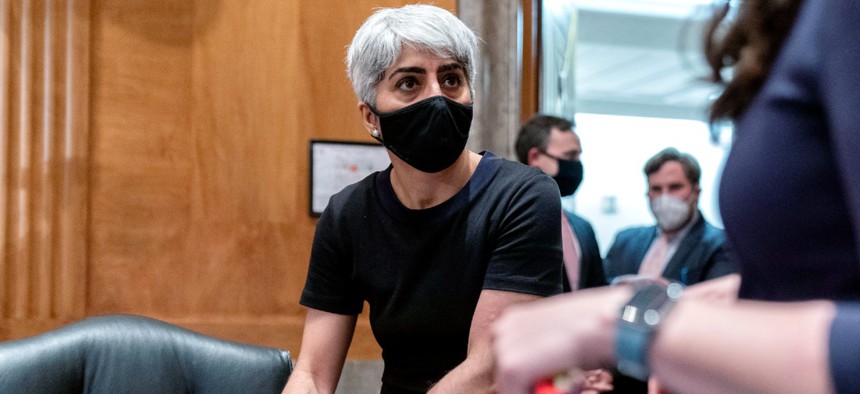New OPM Director Committed to 'Rebuilding' the HR Agency, Federal Workforce
Ahuja says she wants the agency to reassert itself in helping departments governmentwide become model 21st century employers.
Office of Personnel Management Director Kiran Ahuja on Wednesday outlined an aggressive agenda to develop “21st century” personnel policies for federal agencies and attract the next generation of civil servants, but said that work needs to start internally at the federal government’s HR shop.
Ahuja, who previously served as OPM’s chief of staff during the Obama administration, was confirmed by the Senate in June by the slimmest of margins—Vice President Kamala Harris had to break a tie after Republicans attacked Ahuja's alleged support for critical race theory over her citing anti-racist author Ibram Kendi in a past opinion column.
In a discussion with reporters Wednesday, Ahuja said she has spent the last six weeks becoming reacquainted with an agency that struggled through a lack of leadership and an unsuccessful effort by the Trump administration to disband it and send its duties to the General Services Administration and the Executive Office of the President. Amid the chaos of the proposed merger and a global pandemic, OPM saw an exodus of employees, some in very senior positions, and mistrust among employees, something Ahuja said she is working hard to mend.
“I think what’s been helpful is that I come in already having some of those relationships with staff, so it feels like a bit of coming home, reconnecting with individuals, although I miss not seeing the faces of those who have left,” she said. “So we’re spending a lot of time ensuring we are sharing information in real time with the agency and holding regular town halls. And I’ll be starting some listening sessions with groups of employees, and we’re focusing quite a bit on hiring and really filling some of these critical positions.”
Ahuja said she wants employees to see her as approachable and eager to listen to their concerns and ideas. Rebuilding and re-empowering a workforce that was notoriously kept at arm’s length from a growing number of political appointees at the agency will be key to an ambitious agenda that she said is already under development.
“We want to find the right balance like [the National Academy of Public Administration] recommended, between our statutory responsibilities around compliance and really being solutions oriented and meeting the challenges we see across the federal government,” Ahuja said, referring to a recent NAPA study on the future of OPM. “I would say also that we’re really pushing forward and in the midst of building an affirmative agenda, with regulations, proposed legislation and other things through guidance . . . It’s not going to be something that’s done overnight, but we’re hoping that we’ll send signals in both small and big ways that this is the direction we want to move.”
In the weeks since Ahuja became director, OPM has already issued guidance on how agencies should approach telework following the COVID-19 pandemic, and has promised more guidance on the subject of remote work. One area where Ahuja said she wants OPM to reassert itself is in helping managers to do their jobs better.
“I’ll admit that as a manager, I was not a true believer in how to manage people virtually, but I was proven wrong, and part of the issue with telework has always been resistance among supervisors, which was a massive hurdle to get over, but to some extent we’ve done that,” she said. “So now the question is: what support can we provide managers to manage well and support individuals in their work, not just in terms of accountability but engagement and onboarding new employees? How do we create that connection when we’re not spending as much time face to face?”
Ahuja said her agency is also working on scaling up efforts that began under the Trump administration to reform the federal hiring process, leaning more on assessments conducted with subject matter experts, as well as initiatives to make it easier for employees to more easily move between agencies, or to leave government and rejoin after a stint with the private sector. And staff are working on initiatives that have been long-running “pain points” for the agency, like difficulty processing retirement claims, something that has only gotten more difficult with the COVID-19 pandemic.
“The challenge there has been that we have not been able to put the attention on retirement services that we wanted to,” she said. “When I was here last, it was during the data breaches, and then the departure of the [National Background Investigations Bureau] put OPM in a precarious financial situation, and then also the potential for the [GSA] merger, I think it did not allow for the concerted leadership and attention it needed.”
OPM has started tackling the issue in a more comprehensive fashion now, Ahuja said. A senior IT advisor is focused on the issue, and has been directing “sprints” where staff focus for weeks at a time on a specific problem, and the agency is planning a pilot program to develop an online retirement claims app and setting up a new contact center to help new retirees through the process.
“In the long term, we need a robust strategic plan, and there hasn’t been one with retirement services since 2012,” she said. “So this is a mix of both providing immediate benefits, and the dogged leadership attention. It’ll take multiple years, and I’m committed to do that . . . I’ve said multiple times that I plan to be here as long as people will have me, to be here for the long haul.”




